
Building a Wood-fired Masonry Oven
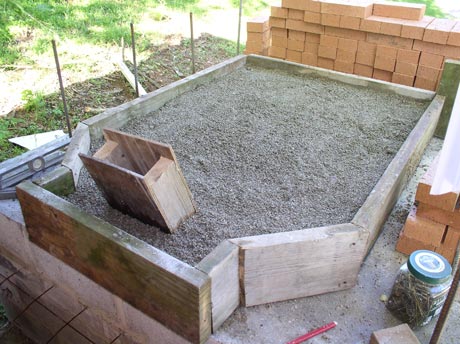
Hearth floor framed and insulated using "vermicrete" — a 9:1 vermiculite to concrete ratio — is in place. Vermicrete forms a temperature barrier between the open ash dump below the foundation slab (see image below), the actual support slab beneath the hearth (shown here framed up), and the hearth bricking that will be put over the hearth slab. The hearth is 36 x 48 inches, maintaining the ratio that Alan Scott determined necessary for optimum efficiency of a wood-fired oven. In his research, Mr. Scott found that the 36x48 size was the most common found in old farmstead ovens in America and Europe, where families baked their breads once a week.
Fire brick visible stacked behind the hearth slab are not set in place; they're just piled up handy for when needed in the next stage of construction. In this construction, fire brick was used instead of red brick because the oven is intended to be fired at temperatures greater than 900°F. High initial firing allows the entire masonry structure to be fully charged with heat, which in turn allows longer baking times at optimal temperatures for crusty "artisan" loaves.
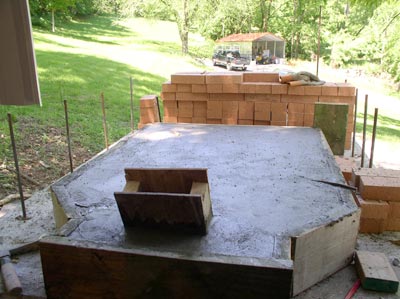
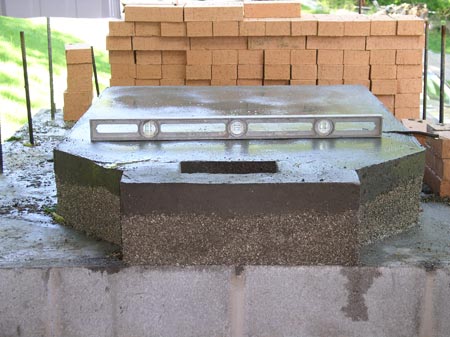
Hearth slab poured (left image) and the next day (we told you . . . this was a morning project!) the frames were removed, surface hosed and checked for level. Perfect! In the right-hand image, the vermicrete layer is clearly visible under the concrete slab. And in this image you can see how the hearth is situated on the larger slab beneath, leaving room all around. The area surrounding the hearth slab will be filled with more insulation, everything being done to retain INSIDE the oven, as much as possible, the heat generated by the fire.
MASS is the key to a successful masonry oven
Hot masonry produces a continual thermal recycling, moving heat from the higher temperature areas to the lower temperature areas in its effort to remain in a state of equilibrium throughout the mass (the second law of thermodynamics; the principle of entropy). Because of the high initial firing heat, subsequent firings will not require much wood to bring the heat back within proper baking range.
When fully charged and once the fire is removed, this particular oven cools to baking temperatures in about 8 hours, and holds heat in the range of 500° to 575°F for about 12 hours, allowing baking of various types of breads over an extended period of time, making it very efficient for commercial use (it takes 15 to 30 minutes to recharge the hearth after removing a load of baked bread). Other baked items, requiring less heat (in the range of 350° to 400°F) can be baked over several days, as the oven gradually cools between firings. Even during winter with exterior temperatures ranging between 15 and 40 degrees (F), the oven has enough mass and insulation, that after a full charge and several bakes, it will stabilize its temperature at about 350°F and hold it there for several days.
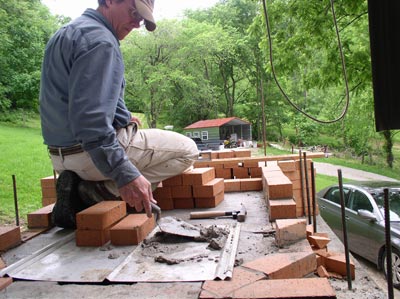
First rows of the hearth walls are mortared into place. The brick was individually cut to follow the shape of the hearth slab.
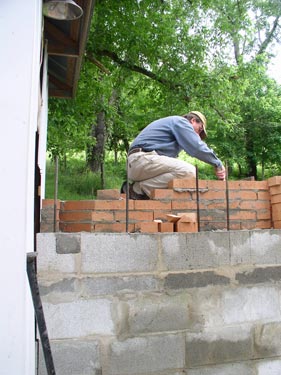
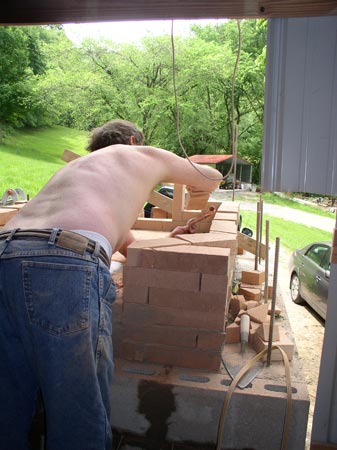
Outside walls of the oven are mortared into place (left image); the copper tubing is going to be a conduit for the lower hearth thermocouple probe that will be embedded 4 1/2 inches under the hearth surface where the fire will be built to heat the oven. There will be a total of four thermocouples placed in the bricking to give readings on the hearth floor and dome. Besides these four digital read-out devices there will also be an analog thermometer in the dome, connected to a gauge situated on the oven face inside the bakery.

Hearth bricking on the sidewalls is complete; the ash dump opening is visible at the front. The wide opening (finished size is 19 inches to allow for full size baking sheets) in the front wall is where the oven door will be installed; the opening in the far wall (two upright bricks) is for the chimney. Unlike many masonry oven styles, this oven was designed with the chimney at the rear of the oven. This accomplishes at least FIVE things : (1) it reduces the amount of smoke belching out into the bakery when the oven door is opened; which also (2) prevents smoke staining on the inside of the bakery; (3) it reduces the depth of the throat at the opening of the oven — the only purpose for the throat is to allow space for the chimney flue; which (4) means that the baker can reach into the oven more easily without having to lean through the throat area; and (5) it makes it easier to build and manage your fire because the airflow through the wood stack is improved, drawing air from the oven door through burning stack, and out the rear chimney. As the fire progresses you simply push it deeper into the oven to heat the entire hearth and dome evenly. The chimney flue will have a damper built into it that is controlled from inside the bakery using a pull lever, thus improving the management of the fire burn by being able to shut or open the amount of air flow as needed to maintain a good burn. Ovens built with the flue/chimney at the front control the "damping" of the fire by how the door is situated at the throat, and airflow cannot be easily manipulated.
cfi©2000-2011 | Contact the Webmaster

